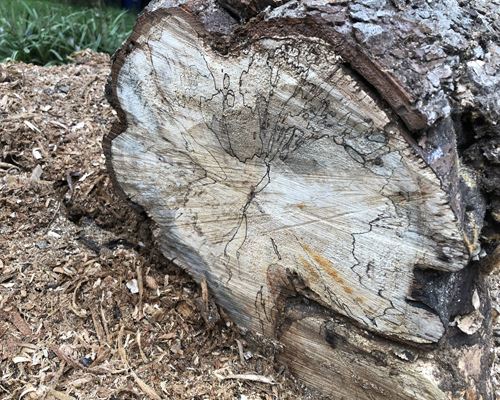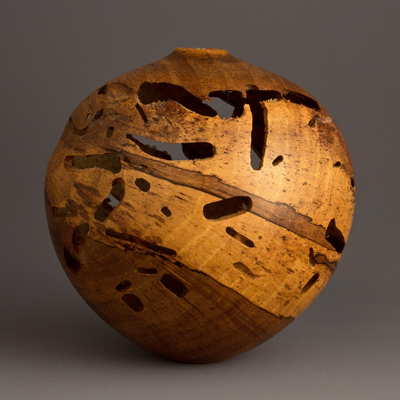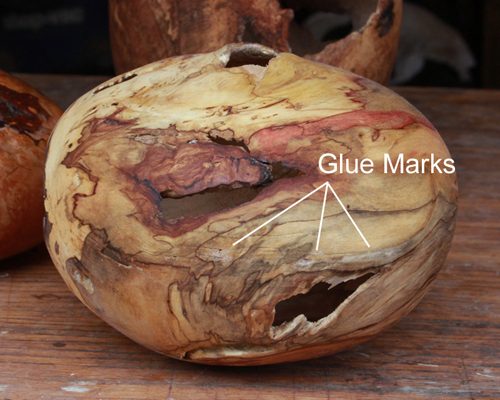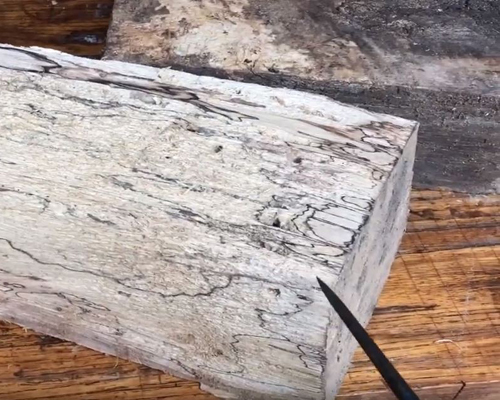
Ben Owen Spalted Pecan
Spalted wood is one of my main turning materials, when considering wood with some figure. I primarily turn sculptural vessels and cremation urns and proactively take steps to spalt a lot of the wood that I gather. In my area spalted maple is most common and the most diverse spalting species. That being said I spalt just about every species that I get a hold of. This article covers information on what spalting is and how it can be used in woodwork, specifically wood turning. Jump to the list of materials at the end of the article.
Now for some Spalted Wood Background…
So what is spalted wood or what does spalted mean? Not surprisingly most people (outside of woodworkers) have no idea what spalting is, even autocorrect doesn’t have a clue. Spalting is a common woodworking term used to describe the colorations and patterning created by the growth of fungus in wood. If you have seen it its probably been some spalted maple.
From “Spalted Wood” (Sara Robinson) “spalting is a process that occurs on wood when fungi colonize the substrate and extract various nutrients”. By the way, “Spalted Wood” is an excellent book and goes a lot more in depth than this post will. Generally, spalting results in the creation of zone lines and staining, the color of which will be influence by the type of fungus present.
Most commonly (in my area) blues, grays, browns, and blacks are found primarily in spalted maple. However, yellows, oranges, reds, purples, whites, and greens are also possible. In actuality the whole spectrum of colors is possible, these are just the most prevalent in my climate. These stains are a lot more UV resistant than commercially developed colorants today.
The species of tree also plays a role as some types of fungus prefer certain species of tree. Thus, some colors are more common in cooresponding species, i.e. bluegreen stain in holly, blue stain in maple, brown rot in oak, etc. Likewise, I usually only find red stain in magnolia, sweet gum, tulip poplar, and spalted pecan. People have been using spalted wood in woodwork, art, and sculpture for hundreds of years.

Ultra Gloss Fine Line Spalted Dogwood
Zone lines are the black (most common), gray, brown, etc. patterns of random lines created in the wood. They are the visual representation of the interface boundary created when two opposing fungi grow and come in contact with one another. Zones lines are extremely diverse in their thickness and arrangement. With zone lines, no two pieces of wood are identical. Horsehair pottery creates an effect that is similar to zone line patterning.
Looking at the spalted Dogwood shown here, the precision or line weight of the zone lines is so fine. I refer to this as “fine line spalting” (my term) and I find it absolutely incredible. For me its rare as I have only ever found it in this particular Dogwood tree and one other spalted maple burl that I have found. Treasure it if you ever find any.
…how to find spalted wood…
Perhaps you are wondering how to find spalted wood? The easiest way is to look for flushes of mushrooms on the wood surface. Spalting is a by-product of the decay process in trees, so the wetter the climate the greater the degree of spalting. Moisture is critical for the decay process so arid climates are naturally going to have limited to no spalting. Where I live everything spalts if left outside.
Spalting in wood is a double-edged sword for the woodworker. Fungal activity creates attractive patterns though it comes at the cost of the wood’s structural integrity. The longer the wood is left to spalt the greater the risk that the wood is no longer usable as it breaks apart too easily. Wood is referred as being “punky” when it reaches this condition. There is a bit of an art in knowing when to stop letting the wood spalt before it is no longer usable.
Fungi require moisture so cover up the wood and let it dry out to stop the wood from spalting. Conversely, if trying to promote spalting in arid climates then keep the wood covered and wet. Mike Jackofsky I recall sprays his burls that he purchases with a hose and covers them up (He is in the San Diego area). He says it helps bring out the color in the burl, though I wonder if fungi might have something to do with it.
Other factors that influence spalting rates are the age of the tree and the species of the tree. Sapwood spalts much more quickly than heartwood, the fungi feed more rapidly on the sugars in the sapwood. Older trees tend to have less sapwood than younger ones and generally decay less quickly. Oaks are a good example here, as the sapwood will spalt in a few months and the heartwood is basically untouched.

Spalted Persimmon with Insect Galleries
Some species of tree just rot more quickly than others. Walnut and Black Cherry for example basically do not spalt, other than the sapwood. I have found that softer wood trees, i.e. softwoods and less dense hardwoods usually spalt more quickly. Persimmon is an exception to this as it rots very quickly by comparison to other hard dense woods. I suspect this is due to the high degree of sugars in the wood itself. Freshly cut persimmon oozes a sap that is sticky and gelatinous. That may promote more fungal/insect activity.
Insects go hand in hand with fungi growth. Some insects feed on the fungi in the wood and other times the fungi piggy back on the insects. “Ambrosia Maple” is caused by the fungi that trails with the Ambrosia beetle that bores through the maple tree. The ambrosia stripes could be considered a form of spalted maple. Either way insects are always going to be around when wood is decaying. Limiting the amount of insect damage requires some form of pest management. Personally I don’t mess with insecticides on my wood, I just let the wood do its thing.
Another benefit of spalting, aside from the nice visual qualities, is the softening of the wood. Some species, pecan and elm come to mind, can be extremely hard. Some areas of pecan are so hard that they will dull a turning tool almost instantly. I like to spalt all hard dense species as it softens the wood and makes it much easier to turn even when dry.
Turning some Punky Spalted Maple…
For the most part the turning of spalted wood is not a problem (click here or the pic for the video). An awl is a good tool to have around to check on the condition of the wood before mounting it on the lathe. If the wood is too “spongy” then I won’t use it in the first place. Just poke the suspect areas with the awl to see if there is wood that still has sufficient structural integrity.
In practice, if the awl pokes into the wood too far then its most likely not worth wasting time on. I would say if it sticks in more than 1/8” then its probably not that good to use. Ideally the awl just scratches the surface of the spalted areas.
Also keep in mind that wet spalted wood is going to feel more spongy than if it were completely dry. This stuff is going to flex if you poke it with your finger. Some wet spalted wood is usable if dried very well, so it its punky I make sure its very dry. The wet spongy stuff is going to pose too many complications with turning so its best to let it dry or not use it at all.
Sanding spalted wood poses the greatest challenge. Areas that have degraded abrade and cut more quickly. I like to start with 80 grit discs as a final shaping step, so that grit size is very aggressive. Sanding those areas typically lead to depressions resulting in irregular surfaces. This may or may not be an issue, personal preference comes into play here. Either way use sandpaper that cuts well to avoid applying excessive pressure. Also avoid sanding the spalted areas for too long, the idea is to minimize its exposure. In some cases I start with 120 or 180 grit discs if the cuts have been clean and the vessel shape is smooth. Here is a link for the sanding disc arbors.
Hollowing spalted wood may result in areas that have cut too aggressively from the inside of the vessel. This happens less frequently but keep it in mind so as to avoid thin spots. Sanding depressions also contribute to thin spots in a vessel wall.
Finishing Spalted Maple and other Spalted Species
Salted wood is also hyper absorbent, so it soaks up finishing oils very aggressively. Usually the stabilizing of the wood results in some yellowing of the wood. I coat my hollows with Danish oil before beginning hollowing. On spalted areas I keep applying oil until the oil rests on the surface. Otherwise the surface of the spalted wood will be very flat.

Red Stain Sweet Gum


